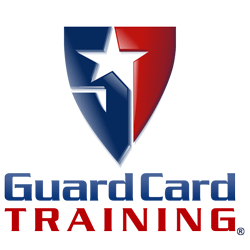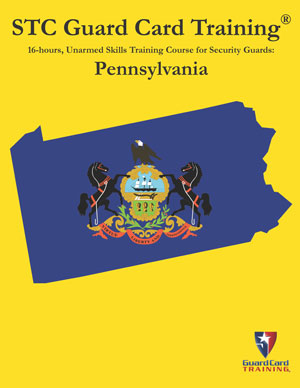
Pennsylvania Security Guard Training Manuals
These training manuals are intended for use as part of an instructor-led course in accordance with the Pennsylvania Administrative Code. These manuals may be used exclusively by certified private security guard trainers in approved and licensed facilities.
Price: $84.99 (plus tax, shipping/handling)

16-hours, Unarmed Skills Training Course for Security Guards: Pennsylvania
248 pages.
Every lesson includes Knowledge Checks and References for further study.
This manual is divided into thirteen (13) lessons:
- Lesson 1: Introduction
- Lesson 2: Power to Arrest
- Lesson 3: Searches
- Lesson 4: Evidence
- Lesson 5: Use of Force
- Lesson 6: Legal Liability
- Lesson 7: Documentation and Report Writing
- Lesson 8: Access Control
- Lesson 9: Counterterrorism
- Lesson 10: Fundamentals of Patrolling
- Lesson 11: Ethics
- Lesson 12: Professionalism
- Lesson 13: Handling Difficult People
Lesson 1: Introduction
Back to topObjectives:
- Recognize Responsibility and Authority of a Security Guard.
- Understand Laws and Regulations pertaining to private security work.
- Properly wear uniforms and display identification.
- Know requirements to obtain and maintain private security permit.
Lesson 2: Power to Arrest
Back to topObjectives:
- Describe the law of arrest as it pertains to private security in Pennsylvania.
- Differentiate the fundamentals of criminal law as it pertains to private security.
- Recognize the Pennsylvania State Statutes.
- Explain differences between detention and arrest.
- Summarize and define false imprisonment.
- Describe how to properly apply handcuffs
- Know the responsibilities of a private security guard.
Lesson 3: Searches
Back to topObjectives:
- Define seizure as it applies to private citizens.
- Describe the limits of search and seizure as it applies to private security in Pennsylvania.
- Interpret the Pennsylvania State Statutes.
- Conduct an appropriate area search.
- Protect an incident scene.
- Conduct an appropriate frisk.
- Understand the limits of searches during a detention.
Lesson 4: Evidence
Back to topObjectives:
- Identify common forms of evidence.
- Explain proper care and handling of evidence.
- Summarize the correct procedure to secure a scene.
- Describe common legal issues regarding evidence.
- Collect appropriate information from witnesses.
- Identify types of evidence.
Lesson 5: Use of Force
Back to topObjectives:
- Describe the law of arrest as it pertains to private security in the Pennsylvania.
- Paraphrase the responsibilities of a private security guard.
- Recognize the Pennsylvania State Statutes.
- Interpret the appropriate use of reasonable force.
- Describe the Use of Force Continuum/Ladder.
- Explain the use of restraint techniques and their implications.
- Explain the use of deadly force.
- Recognize pre-assault indicators.
- Describe the use of force in property defense.
- Explain escalation and de-escalation techniques in the use of force.
Lesson 6: Legal Liability
Back to topObjectives:
- Define the difference between the court proceedings and the burden of proof for criminal and civil courts.
- Describe the penalties for criminal prosecution and civil litigation.
- Understand the personal liability of security guard.
- Define liability of the guard company.
- Define liability of the client.
- Describe differences between the criminal and civil process.
- Describe the role of the security guard.
Lesson 7: Documentation and Report Writing
Back to topObjectives:
- Write an effective report.
- Take descriptive and useful field notes.
- Demonstrate objectivity in report writing.
- Complete common types of reports.
Lesson 8: Access Control
Back to topObjectives:
- Describe access control.
- Interpret the fundamentals of manual access control systems.
- Interpret the fundamentals of automated access control systems.
- Apply identification procedures to on-site personnel.
- Explain the fundamentals of alarm systems.
- Describe the fundamentals of trespass.
Lesson 9: Counterterrorism
Back to topObjectives:
- Identify functions of major counterterrorism agencies.
- Describe the nature of terrorism.
- Explain the goals of terrorism.
- Describe the differences between homegrown violent extremists and international terrorism.
- Identify the common homegrown violent extremists and organization goals.
- Identify suspicious behavior.
- Better protect their post from terrorist threats.
Lesson 10: Fundamentals of Patrolling
Back to topObjectives:
- Apply appropriate patrolling techniques and methods.
- Describe how to handle suspicious activity.
- Explain how to ask appropriate questions.
- Apply accident and fire prevention techniques.
- Properly employ all senses in observation.
- Conduct an efficient and productive patrol.
- Conduct an appropriate interview.
Lesson 11: Ethics
Back to topObjectives:
- Recognize and avoid gender and racial harassment.
- Recognize and avoid discrimination.
- Develop respect of others.
- Understand the principles of ethical behavior.
- Describe how to avoid conflicts of interest.
- Identify ethical violations.
- Explain how to report unethical behavior.
Lesson 12: Professionalism
Back to topObjectives:
- Know how to project a friendly, professional image.
- Describe the importance of positive public relations.
- Demonstrate Command Presence.
- Understand the sources of power.
- Explain the importance of maintaining a clean, sharp uniform.
- Define good public relations.
Lesson 13: Handling Difficult People
Back to topObjectives:
- Summarize four specific reasons why consumers may become violent.
- Identify personal reactions to confrontation.
- Describe personal Risk Factors related to violent behavior.
- Explain the Stress Model.
- Discuss the Theoretical Models of Assault.
- Define how the working environment can affect behavior.
- Configure a safe working environment.
Licensing Contact
For more information on our licensing programs, please contact:

Information provided on this site is for educational purposes. It is not legal advice.

